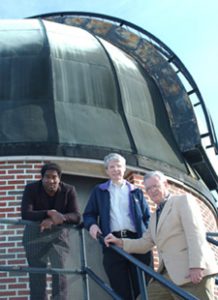
Astronomers from The University of Alabama and Bevill State Community College recently presented remarkable Hubble Space Telescope images of the disk of a distant spiral galaxy.
Tarsh Freeman, professor at Bevill State Community College, and Drs. Gene Byrd and Ron Buta, professors of astronomy at The University of Alabama, presented the images at the American Astronomical Society meeting in Washington, D.C. The galaxy, known as NGC 4622, lies 200 million light years away in the constellation Centaurus. The images are of special interest because they solve a mystery about the galaxy that has lingered for more than a decade. The mystery was connected to the galaxy’s spiral arms.
“Fifteen years ago I noticed something unusual in a picture of NGC 4622 from a well-known undergraduate textbook,” said Byrd. “The galaxy was presented in the text as a superb example of a spiral galaxy, with two bright spiral arms that open outward in a clockwise direction. However, in the inner parts of the galaxy, I noticed another spiral arm that wound in the opposite sense to the two others. I immediately suspected that NGC 4622 has leading spiral structure, a phenomenon which, up until that time, had not been definitively recognized in any galaxy.”
It has long been believed that most spiral arms seen in galaxies are trailing, meaning they wind outward opposite the direction of rotation of the disk material, something like what one sees while stirring cream into a cup of coffee. A leading arm does the opposite, opening outward into the same direction as the rotation of the galaxy’s disk.
“We had thought since 1993 that the outer pair of arms trailed,” said Byrd. “These two arms were strong and there were good theoretical reasons to believe they were trailing. However, in order for them to be trailing, the galaxy would have to be spinning counterclockwise. The Hubble Space Telescope data told us that the galaxy was, in fact, spinning clockwise. This gave the surprising result that the two outer arms have the leading sense, not the weaker inner arm.”